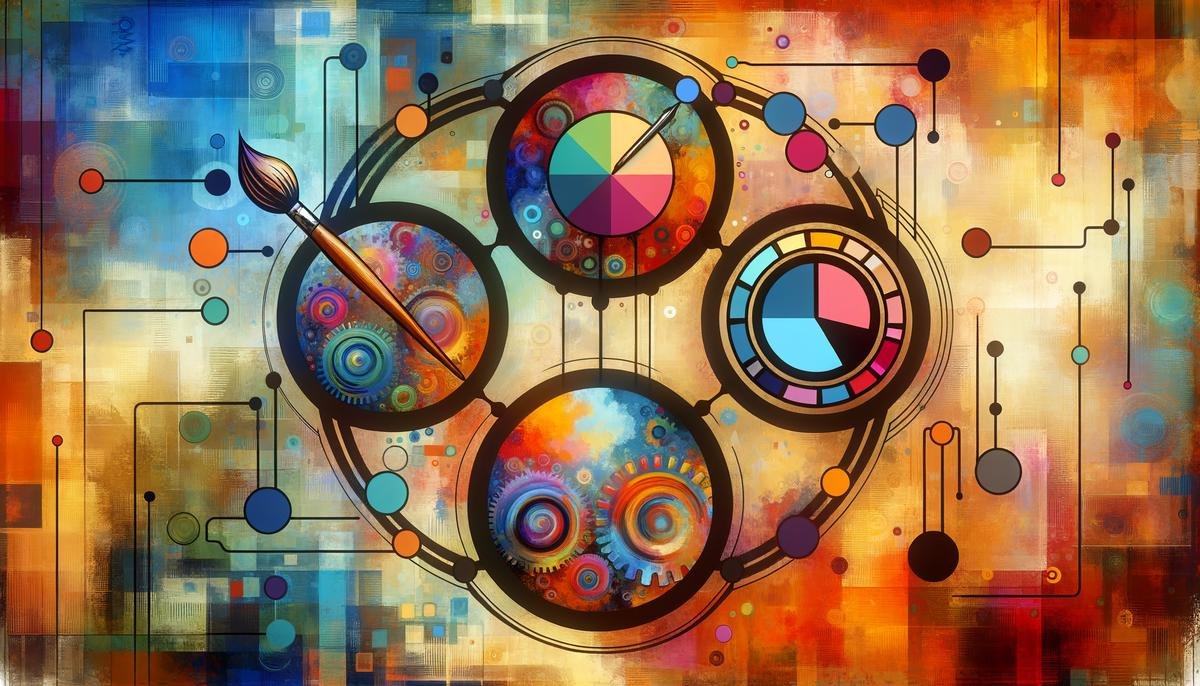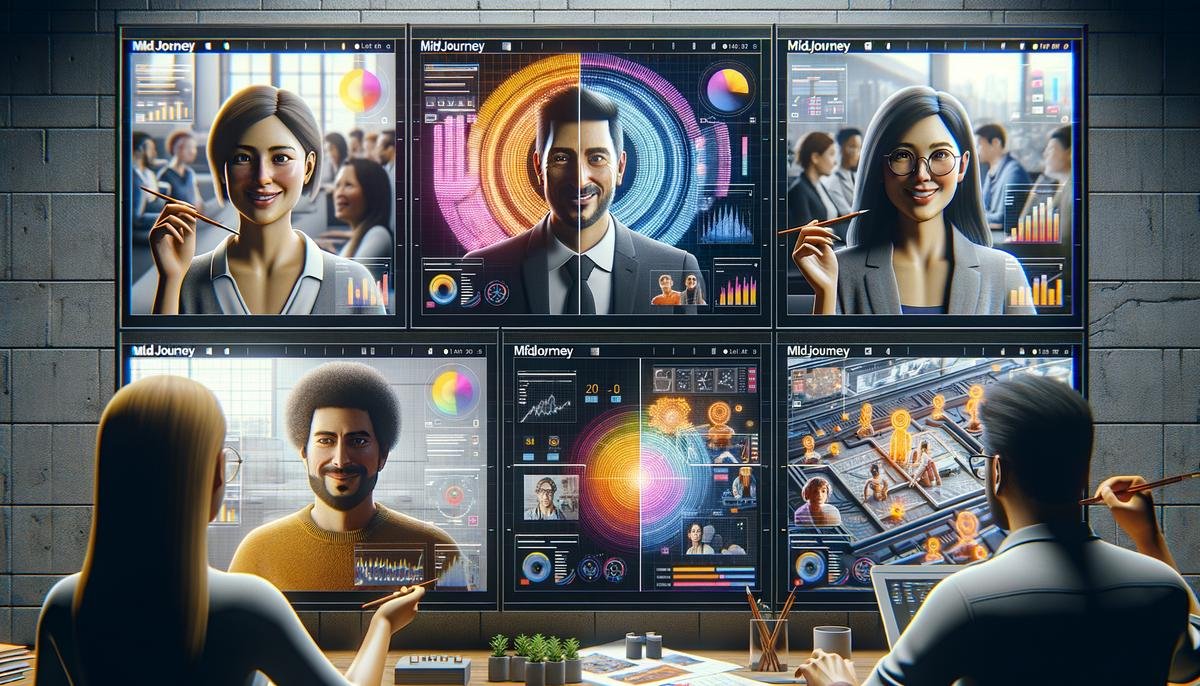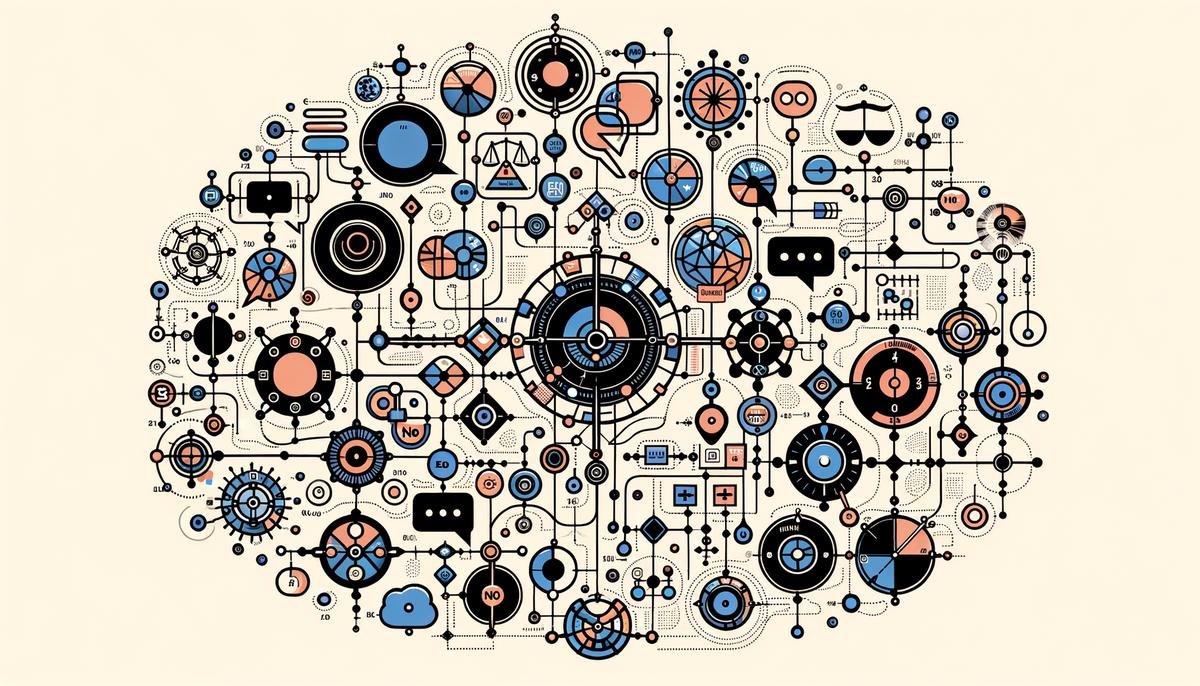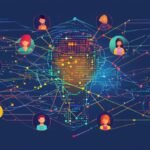Midjourney AI offers a powerful tool for transforming ideas into visual art, regardless of one’s artistic background. By leveraging advanced technology, it bridges the gap between imagination and tangible creations, making high-quality visual content accessible to all.
Understanding Midjourney AI
Midjourney AI is a creative tool that enables anyone to generate visual art, regardless of their artistic skills. Founded in 2022, it uses deep learning models and natural language processing to transform user inputs into visual outputs.
At its core, Midjourney uses diffusion models to create images. It can reverse digital noise to piece together recognizable and artful images from user prompts.
Primary Functions
Midjourney AI offers three main functions:
- Image Generator: Create images from text prompts across various categories.
- Image Editor: Apply filters, text, stickers, and effects to refine your creations.
- Image Mixer: Combine multiple images to create collages, mashups, and hybrids.
Unique Features
Midjourney provides additional tools to enhance your creative process:
- Upscaling: Transform thumbnails into high-resolution images.
- Iterations and Variations: Generate multiple versions from an initial prompt.
- Parameters: Fine-tune your creations with controls for aspect ratio, quality, seed, stylization, and uniqueness.
These features allow users to refine perspectives, guide the AI with precise language, and even remove unwanted elements through negative prompting.
Real-World Applications
Midjourney AI has practical applications across various industries:
- Marketing: Create eye-catching visuals quickly.
- Education: Develop interactive and engaging learning content.
- Entertainment: Generate characters, scenes, and backgrounds efficiently.
By offering these tools and features, Midjourney transforms vague ideas into polished, shareable content, making it an essential tool for today’s digital artists.

Midjourney’s Tools and Features
Midjourney AI offers a range of tools that enhance the creative process:
- Text-to-Image Generation: Transform written descriptions into visual art.
- Image Upscaling: Enhance the resolution of chosen images for high-quality prints or digital displays.
- Variations and Iterations: Explore different versions of an initial concept or refine specific variations.
- Parameters and Control: Fine-tune your creations with adjustable settings:
| Parameter | Function |
|---|---|
| Aspect Ratio Control | Customize image dimensions |
| Quality Setting | Balance between quick drafts and detailed images |
| Seed Control | Replicate or vary images using numerical seeds |
| Stylize Parameter | Adjust the level of artistic flair |
| Weird Factor | Add unpredictability for abstract or whimsical results |
These tools allow for extensive customization and experimentation in the creative process. For example, you could start with a prompt like “An ethereal forest with luminescent trees and mythical creatures,” then use variations, upscaling, and parameter adjustments to refine the result.
Midjourney also fosters a community through platforms like Discord, where users can share creations, gather inspiration, and exchange tips. This collaborative environment enriches the user experience and pushes the boundaries of creative possibilities.
Practical Applications of Midjourney AI
Midjourney AI has diverse applications across various industries:
- Marketing: Create unique, high-quality images for campaigns quickly. For example, a travel agency could generate inspiring visuals of destinations for social media, brochures, and digital ads.
- Design:
- Architecture and Interior Design: Visualize concepts before detailed planning.
- Fashion: Prototype potential designs by combining textures, colors, and unique elements.
- Entertainment:
- Game Development: Draft concept art for characters, environments, and props.
- Film and Television: Create visual references for set design and special effects.
- Education: Generate custom visuals to accompany lessons, making abstract concepts more tangible and enhancing student engagement.
Case Studies:
Sarah, a freelance graphic designer, used Midjourney to create a branding package for an artisanal coffee company. She generated logo ideas, product imagery, and marketing materials that aligned with the client’s vintage-inspired vision.
Alex, a high school history teacher, transformed his lessons into dynamic visual experiences. For a lesson on the Industrial Revolution, he used Midjourney to create vivid imagery of 19th-century factories, helping students better understand and appreciate historical contexts.
Midjourney AI serves as a versatile tool across professions, fostering efficiency and creativity. As more professionals integrate this technology into their workflows, it’s opening new possibilities in digital artistry and visual communication.1

Mastering Midjourney Prompts and Parameters
Creating with Midjourney is exciting, and understanding how to use it effectively can elevate your final product. Here are some advanced techniques to help you get the most out of Midjourney AI:
Specific Language: Your Blueprint for Precision
Use detailed, clear language to guide the AI. Instead of “a cat,” try:
“An orange tabby cat playing with a red ball of yarn on a wooden floor in a cozy living room with sunlight streaming through a window.”
Multi-Prompting: Combining Ideas
Break down complex prompts into distinct chunks separated by double colons (::). For example:
"a pirate ship::stormy seas::sunset"
Prompt Weighting: Prioritizing Elements
Assign numerical values to components within your prompt to fine-tune their prominence. For example:
"a bustling crowd::fireworks::evening sky::2"
Negative Prompting: Removing Unwanted Elements
Use the –no parameter to exclude certain aspects. For example:
"a coastal cityscape --no crowd"
Stylistic Consistency: Infusing Artistic Influence
Use the –style parameter to add artistic flair. For example:
"a dense forest with swirling leaves and vibrant colors --style Van Gogh"
Proportion & Perspective: Enhancing Visual Compositions
Use specific language like “aerial view” or “low angle perspective” and pair with the aspect ratio parameter (–ar). For example:
"a majestic mountain range::low angle perspective --ar 16:9"
Chaos: Embracing Unpredictability
The –chaos parameter introduces controlled randomness. Try:
"a futuristic cityscape --chaos 75"
Combining Parameters for Ultimate Control
Use multiple parameters simultaneously. For example:
"a portrait of an elderly man with a weathered face::Rembrandt-style lighting --stylize 150 --quality 2 --ar 3:4"
Iterative Creation: Refinement Through Repetition
Start with a broad prompt and gradually refine it based on outputs. Begin with “a vibrant spring garden” and enhance with subsequent prompts.
Real-world Examples
- For an architect designing a futuristic urban park:
"futuristic park with illuminated pathways::integrate solar lighting::people enjoying the space --stylize 200 --ar 16:9" - For a fashion designer planning a new collection:
"a haute couture gown with floral embroidery::lace accents::soft pastels --quality 2 --stylize 300"
Mastering these techniques can transform vague ideas into distinct, custom visuals. Whether you’re a marketer, designer, educator, or artist, these advanced techniques can help you fully exploit the potential of AI in your creative journey.

Challenges and Ethical Considerations
As we embrace the power of AI-generated content, it’s important to address the challenges and ethical considerations that arise:
Copyright Concerns
AI-generated content often draws from existing artworks and media, raising questions about intellectual property rights. The legal frameworks around AI and copyright are still evolving, and it’s crucial to establish guidelines that protect creators’ rights while fostering innovation1.
Authenticity of Digital Media
AI-generated art lacks the human touch and emotional depth of traditional art. This raises questions about the nature of art and creativity in the digital age2.
Impact on Human Creativity
As AI tools become more sophisticated, there’s a risk of diminishing the role of human artists. However, AI can also act as a catalyst for human creativity, providing new tools and expanding possibilities3.
Responsible AI Use
To address these challenges, we need to adopt ethical guidelines:
- Transparency: Clearly label AI-generated content.
- Fair Use: Respect intellectual property rights.
- Educating Users: Provide guidelines on ethical implications and legal frameworks.
- Promoting Collaboration: Encourage partnerships between AI and human artists.
In practice, this means creating a creative ecosystem where AI and human efforts complement each other. For example, marketers could use AI to generate initial concepts, which human designers then refine. Educators might use AI to create diverse materials, supplemented by expert insights.
As we explore this new landscape, it’s important to balance innovation with respect for artistic integrity. By addressing these challenges thoughtfully, we can harness the power of AI while preserving the irreplaceable spirit of human imagination.

Midjourney AI is a powerful tool that makes creativity more accessible. As we embrace this technology, it’s essential to use it responsibly. The future of digital artistry is bright, and with Midjourney AI, we have exciting new possibilities to explore.




